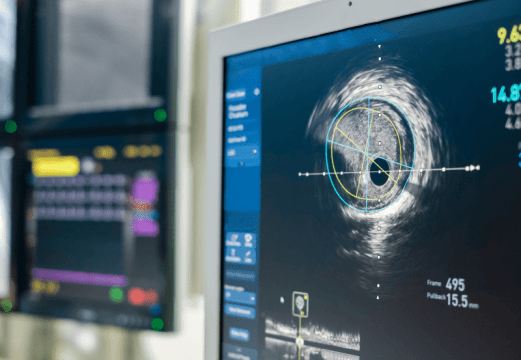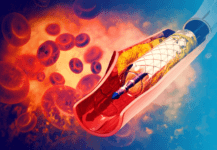Percutaneous coronary intervention (PCI) with drug eluting stents (DES) can present limitations, especially in the form of stent thrombosis or instent restenosis (ISR). These findings have furthered the development of drub coated balloons (DCB). The safety and efficacy of DCB have already been shown in the context of ISR and de novo small vessel coronary…
Biolimus vs Paclitaxel Coated Balloons for the Treatment of In-Stent Restenosis
Drug eluting stent (DES) in-stent restenosis (ISR) is currently a challenging, seeing as it often requires repeat revascularization. The use of drug coated balloons (DCB) offers the advantage of delivering the drug without the need for re-stenting. This highlights the importance of the technological development of DCB, with diverse drug formulations and coating technologies. As…
Coronary Angioplasty with Sirolimus Eluting Stents
At present, most percutaneous coronary intervention procedures (PCI) are done with drug eluting stents (DES). However, drug coated balloons (DCB) have shown benefits in restenosis and small vessel de novo lesions. Intravascular ultrasound (IVUS) has been shown effective in left main PCI and complex procedures, even though there is little infomration on its use for…
BIONYX: Onyx vs. Orsiro At 5 Years
Onyx is a zotarolimus-eluting stent (ZES), designed with thin struts and a platinum core that enhances its radiological visibility. This can be beneficial in complex situations with limited visibility, such as in patients who are obese or present severe calcification, two particularly frequent characteristics in diabetic or elderly patients. The BIONYX study was a randomized…
EuroPCR 2024 | 2 Year Outcomes of the New Sirolimus Eluting Bioadaptor vs Resolute Onyx Zotarolimus Elulting Stent
Stent related adverse events after the first year see a constant 2-3% annual increase, reaching 20% by year 5 and 50% by year 10. BIOADAPTADOR RCT outcomes at 12 months have shown the safety and efficacy of DynamX Bioadaptor, establishing new reference parameters in arterial viability restoration. The aim of this study was to report…
Treatment of Recurrent In-Stent Restenosis with Drug-Eluting Stents: 10-Year Outcomes
In-stent restenosis (ISR) remains the main limitation in the percutaneous treatment of coronary artery disease, with a prevalence between 5% and 10% after implantation of latest-generation drug-eluting stents (DES). Therapeutic recommendations for it include the implantation of a new DES and the use of drug-coated balloons (DCB). The rate of recurrent ISR ranges from 10%…
AGENT-IDE: Drug Coated Balloons for Instent Restenosis
Drug eluting stents (DES) have improved considerably over the years, reducing the initial indices of instent restenosis (ISR) by roughly 5-10% a year in USA. However, DES failure might lead to neointimal hyperplasia and neoatherosclerosis, which increases the chance of developing chronic and acute coronary syndromes. Drug coated balloons (DCB), which administer anti-proliferative agents with…
IN.PACT Outcomes at 5 Years
Over time, percutaneous coronary intervention (PCI) with drug coated balloons (DCB) have been shown more beneficial than conventional PCI. However, in many cases, stenting is required to treat suboptimal results. Even though several studies have looked into this scenario, long term durability still calls for research. This was a 5 year thorough analysis of the…
LIFE-BTK | Critical Limb Ischemia: Use of Bioresorbable Scaffold in Infrapatellar Lesions (LIFE-BTK)
Advanced stages of peripheral artery disease cause significant limitations in patients, such as critical limb ischemia (CLI), which manifests with resting pain and gangrene or ulcers of difficult resolution. Uncontrolled progression of this pathology might lead to major amputation, reduced life expectancy and increased healthcare costs. Prior research on infrapopliteal territory have shown contradicting results.…
Outcomes of the Use of Drug Coated Balloons in the Treatment of De Novo Coronary Lesions
Drug coated balloon (DCB) angioplasty offers a novel strategy for treating coronary artery disease. Studies assessing this strategy have shown clinical outcomes comparable to drug-eluting stents’ (DES) in patients with in-stent restenosis and de novo disease in small vessels. However, evidence for the use of DCB in large coronary vessels is limited. This observational, retrospective study DCB…
iFR Guided PCI to the LAD: Same as for non-LAD Vessels?
iFR has been validated as a useful tool for intermediate lesion analysis, with the advantage of not requiring the use of drugs. On the other hand, its use for PCI outcome assessment has not yet been thoroughly looked into, even though there have been promising data. 24% of DEFINE PCI cases presented ≤0.89 iFR with…







